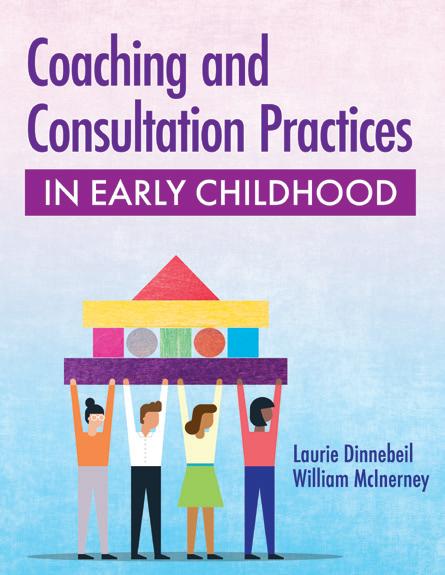TEXT







Coaching is one of the best ways to enhance the skills of early childhood practitioners and ensure high-quality learning experiences for young children with and without disabilities. With this authoritative text, future educators and early interventionists will learn how to use coaching and consultation methods to support inclusion and improve outcomes for all children from birth to five.
Written by two experts on early childhood intervention and special education, this book introduces multiple models of professional collaboration and offers in-depth guidance on how to implement an effective consultation/coaching model in early childhood settings. From big-picture considerations to small logistical details, tomorrow’s professionals will master the entire process of creating, maintaining, and evaluating a successful coaching relationship. In each chapter, case examples, discussion questions, chapter summaries, and group activities reinforce key points and encourage reflection.
An ideal textbook for courses on consultation and coaching, this comprehensive guide will help early childhood practitioners work together to enhance educational and developmental outcomes for all young children.
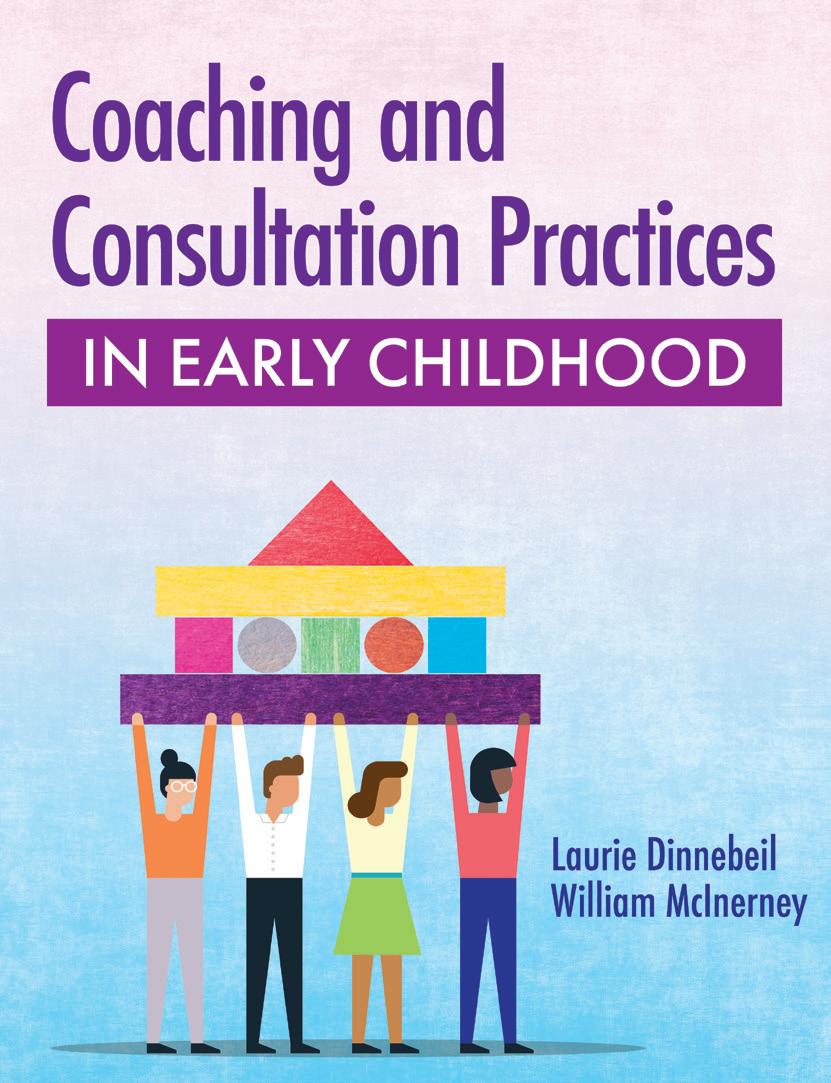
establish ground rules and objectives for coaching
build rapport and strong communication skills within a coaching
systematically gather information about the child, teacher, and learning environment to inform coaching practices
work together to set and prioritize intervention goals for children
and implement an action plan that addresses intervention
performance
success
coaching
tele-intervention,
successful coaching

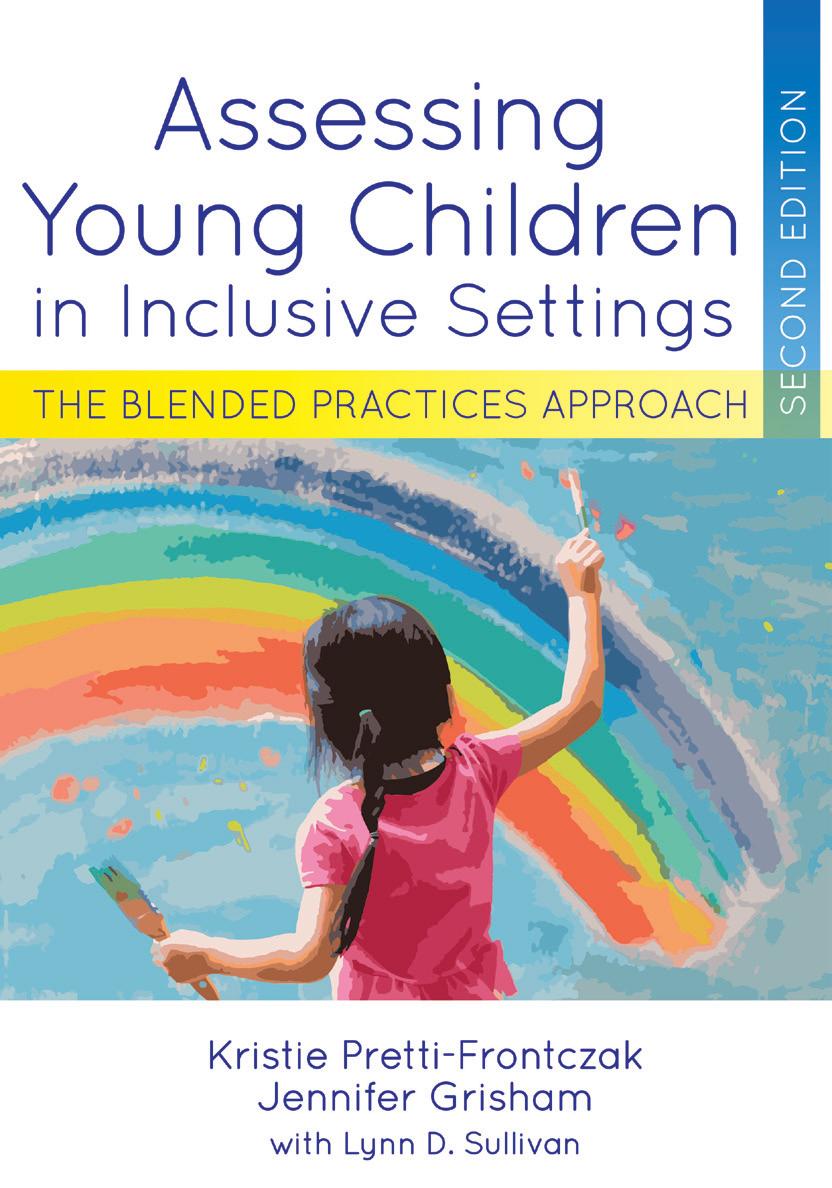
Meaningful, authentic assessment practices are one key to the success of early childhood inclusion. Prepare future teachers with the second edition of this comprehensive textbook, an in-depth guide to the how and the why of high-quality assessment in the context of inclusive early childhood settings.
Updated with new contributors and coverage of timely new topics, this book takes a blended approach to assessment, combining the latest recommended practices from early childhood education and early childhood special education. Well-known experts Kristie PrettiFrontczak and Jennifer Grisham have developed this text to align with Division for Early Childhood Recommended Practices on assessment. Educators will learn how to select and use assessment instruments, conduct authentic assessment during daily activities and routines, master the challenges of kindergarten assessment, conduct eligibility assessments, use assessment to inform program planning and monitor progress, and more.
• New section on considerations for special populations: dual lan guage learners, children in kindergarten, and children who have severe and multiple disabilities
• Increased focus on educational equity throughout the book
• New and expanded coverage of important themes and topics, including authenticity, collaborative partnerships, and data-based decision making
New invited contributors who are experts in the field and advo cates for early childhood inclusion
More practical materials, including new and extended case studies, a revised Curriculum-Based Assessment Rating Rubric and glossary, and a list of recommended practices
Overview of revised versions of commonly used curriculum-based assessments, including AEPS-3, COR Advantage, and Work Sam pling System
Companion materials for faculty, including PowerPoints with links to activities and resources
Introduction
Recommended Practices in Authentic Assessment
Family Involvement in the Assessment Process
Recommended Practices for Determining Techni cal Adequacy
Critical Decision-Making Process
REASONS FOR CONDUCTING ASSESSMENTS

Assessment for Program Planning Purposes
Assessment for Progress Monitoring Purposes
Recommended Practices in Identifying Children for Special Services
Program Evaluation
CONSIDERATIONS FOR SPECIAL POPULATIONS
Recommended Practices for Assessing Children
are Dual Language Learners (DLLs) or Multilanguage Learners
Recommended Practices for Assessing Children with Severe and Multiple Disabilities
Kindergarten Assessment
Prepare SLPs and educators to support the growing population of dual language learners with the third edition of this bestselling textbook— developed by three influential experts on bilingual language development and aligned with Head Start guidelines on cultural and linguistic responsiveness.
Updated with the latest research and recommended practices, this text gives a broad audience of future professionals the clear and comprehensive information they need to promote positive outcomes for young dual language learners and make informed decisions about assessment and intervention when a disorder is present. Your students will get up-to-date guidance on a wide range of key topics, including recognizing the typical stages of second language learning, supporting development in both languages, distinguishing a language delay from a disorder, planning culturally appropriate interventions, addressing reading disorders in bilingual children, and more. New and enhanced student-friendly features make this edition even more engaging and practical, and a robust new package of online support materials will help faculty members use the book effectively in their courses.
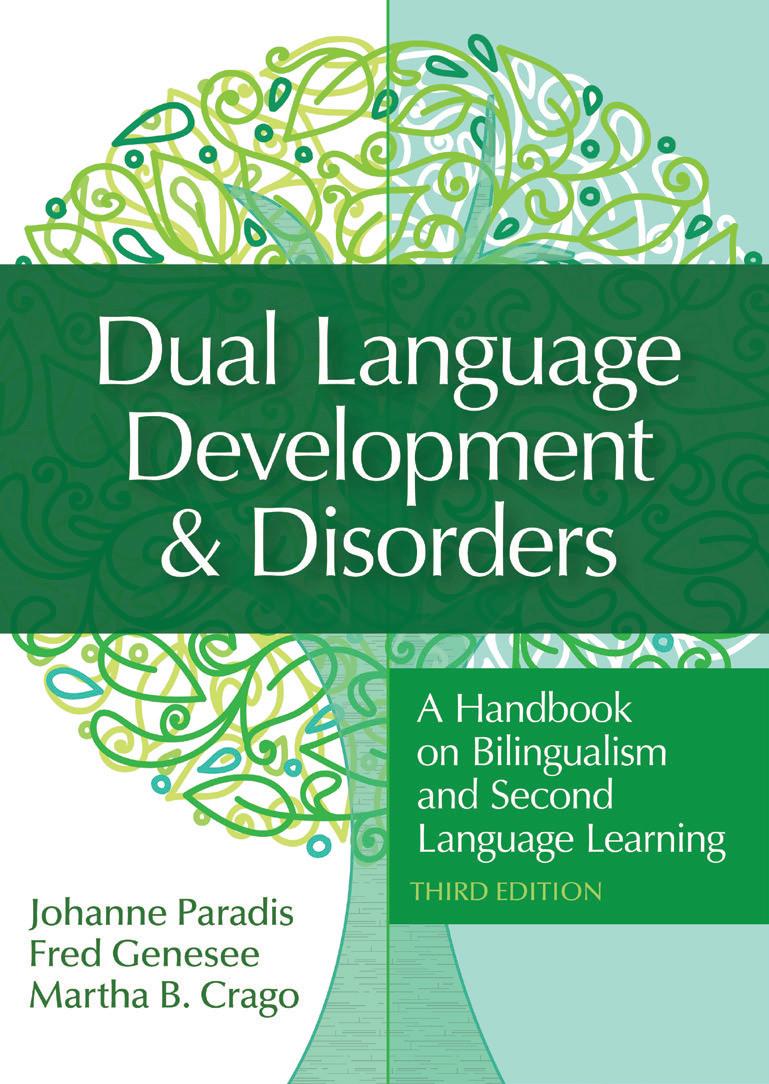

New chapter on supporting heritage language development in children
Important updates throughout the book on best practices
student-friendly
learning
gather
working with culturally and linguistically
questions
class
”An exemplary book that fully captures the state of the field, is well-written for varied audiences, and impactful in its description of findings for practice and policy.”
— Sandra Barrueco, Ph.D., The Catholic University of America
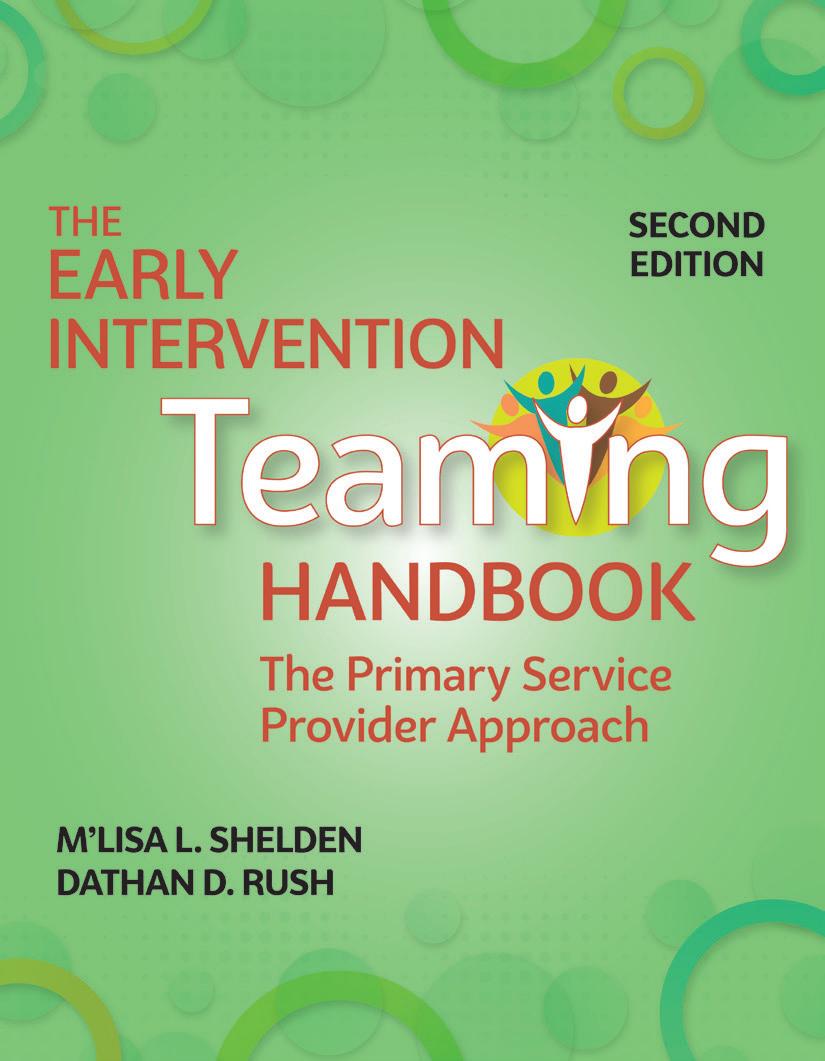
Future early intervention professionals need to know the most effec tive ways to ensure coordinated, family-centered services for young children and families. Prepare them for practice with the second edition of this complete guide to the primary service provider (PSP) approach to teaming, the widely used, evidence-based model that makes one team member the consistent point of contact with a family.
Now updated and aligned with the second edition of Rush and Shel den’s The Early Childhood Coaching Handbook, this text is a blueprint for better, more responsive care and services—and better outcomes for young children and families.
• fully introduce families to the procedures and practices of the PSP approach
• select the most appropriate primary service provider for each family

• gather information, conduct evaluation and assessment, and write functional IFSP outcomes
• adopt a flexible, activity-based approach to scheduling that pro motes child learning and development
• establish a cohesive team that collaborates effectively
• coordinate joint visits with other service providers
• conduct successful, efficient team meetings to share expertise and resources
WHAT’S NEW: Alignment with DEC Recommended Practice • Alignment with the second edition of The Early Childhood Coaching Handbook • New Scenario Index and new Tool Index for easier navigation • Updated section of Frequently Asked Questions • Updated references
PRACTICAL MATERIALS: Realistic case studies and transcripts from team communications give your students vivid demonstrations of best practices, and more than 20 reproducible forms, tools, and checklists will help professionals in the field every step of the way as they implement the PSP approach.
US$44.95
55002
|
978-1-68125-500-2
1. Introduction to a Primary Service Provider Ap proach to Teaming
Research Foundations of a Primary Service Provid er Approach to Teaming Primary Service Provider Approach to Teaming
Preparing for a Team-Based Approach
Steps in Early Intervention: Gathering Information, Evaluation, Assessment, and IFSP Development
Using a Primary Service Provider: Putting the Ap proach into Action
Coordinating Joint Visits
Conducting Team Meetings
The Future of the Primary Service Provider Ap proach to Teaming in Early Childhood Intervention
Edited by Mary Louise Hemmeter, Ph.D. (Vanderbilt University), Michaelene M. Ostrosky, Ph.D. (University of Illinois at UrbanaChampaign), & Lise Fox, Ph.D. (University of South Florida, Tampa)
For more than a decade, the widely used Pyramid Model for Promoting Social Emotional Competence in Infants and Young Children has been helping early educators use research-based practices to boost social-emotional development. Now there’s a practical text that makes it easier than ever to implement this highly effective framework in preschool classrooms.
Created by the Pyramid Model developers and experts with extensive training experience, this is the first book to provide a comprehensive, step-by-step overview of the Pyramid Model for children ages 2–5. Early childhood educators will get a complete overview of the framework, plus in-depth guidance, evidence-based strategies, and helpful checklists for implementing all tiers of the Pyramid Model: universal, targeted, and individualized.
Ideal for use in preservice methods courses, Unpacking the Pyramid Model will give future educators the foundational skills they need to promote positive behavior and build all young children’s socialemotional competence.
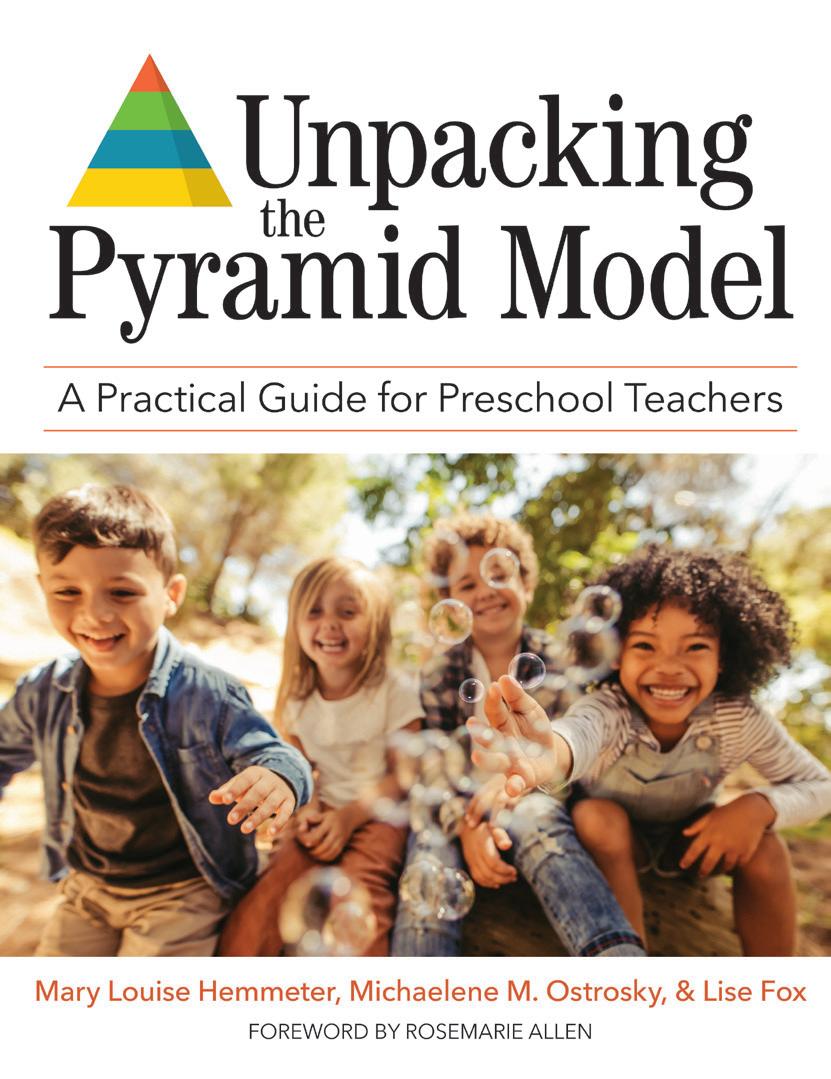
positive classroom environment that supports access
predictable schedules and routines that maximize participation and learning
define and teach behavior expectations and rules
Teaching
Facilitating Social Emotional
intentional, explicit instruction in social-emotional
and streamlined transitions

of
emotions
children
prevent
actively teach children
help them develop
skills they need to solve interpersonal problems
for children with persistent
As the number of dual language learners (DLLs) in early childhood set tings continues to rise, future educators need to know how to teach, engage, and assess children from different cultural and linguistic backgrounds. They’ll have the proven strategies they need with this timely book, a reader-friendly guide that expertly connects research to practice for teachers of young DLLs.
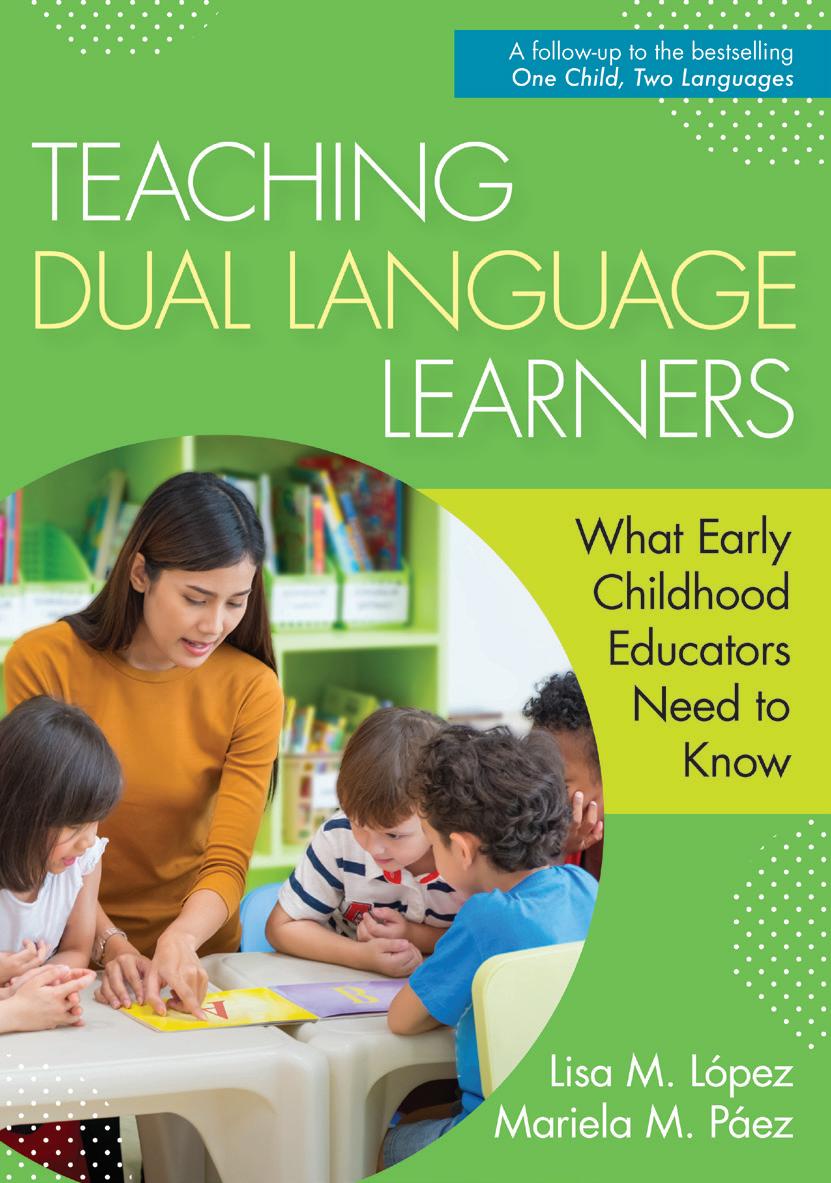
Early childhood educators will start with a detailed review of the demographics of today’s DLLs and the latest research findings on supporting the learning and development of bilingual and multilingual children. Then they’ll find practical, real-world guidance on the best instructional and assessment practices to integrate into their class rooms. Throughout the book, five in-depth case studies of diverse children highlight the importance of considering each child’s back ground, skills, and home experiences when designing effective learn ing environments.
• Connect and work with families, with consideration for their cultural context, practices, beliefs, goals, and diverse experiences
• Internalize eight key beliefs every teacher should have about dual language learning and apply those beliefs to practice
• Implement specific, evidence-based classroom practices that pro mote the learning of young DLLs
• Use best practices to help DLL children develop language and early literacy skills
• Assess the learning of DLLs in culturally valid and linguistically ap propriate ways
• Use the results of assessments to inform instruction

Preservice and in-service teachers alike will benefit from the learning objectives, guiding questions, self-study and reflection activities, and downloadable forms, including a case study template for child obser vations and a helpful resource guide to share with families.
1. Introduction to Dual Language Learners (DLLs)
Working With Families
Examining Beliefs to Promote Culturally and Linguistically Responsive Practices With DLLs
4. Effective Classroom Practices for Working With DLLs
5. Teaching Language and Early Literacy Skills for DLLs
Assessment Considerations and Practices for DLLs
Implications for Culturally and Linguistically Re sponsive Practice
For more than a decade, The Art and Practice of Home Visiting has been a go-to guide for effective, culturally sensitive home visits with young children and families. Now reframed as a textbook for a new generation of home visitors, this second edition includes studentfriendly features, downloadable course companion materials, and fresh content on timely topics.

Presenting a collaborative, family-centered approach to home visiting, Cook and Sparks prepare preservice professionals to form respectful and productive partnerships with caregivers and help each unique family reach their specific goals. Future home visitors will get practical, in-depth guidance on all the complex issues they’ll face in their work with families and children, including implementing evidence-based practice; providing trauma-informed care; and addressing challenges with sleep, feeding, and behavior.
A foundational text for future professionals, this book will help all home visitors master the art and practice of effective home visiting with today’s diverse families.

• New student-friendly features: Learning Outcomes and ReadReflect-Discuss Questions in each chapter, case studies, chapter summaries, and a glossary
Expanded focus on all home visitors working with children with and without disabilities
New and updated content on critical topics, such as resolving barriers to successful home visits and working with culturally, linguistically, and economically diverse families
Expanded table of contents for easy
Increased focus on family-centered home visiting and the home visitor as a collaborative coach and partner for the family
complete package of downloadable companion materials for
ONLINE COMPANION MATERIALS: Faculty members will easily inte grate this book into their courses with the online companion materials, including
sample syllabus, test bank, and PowerPoint outlines.
As more and more early childhood settings implement inclusive practices, teachers need to blend special and general education techniques to help all children learn. They’ll find out how with the new edition of this bestselling text, which combines today’s best practices for teaching young children with and without disabilities into one com prehensive approach.
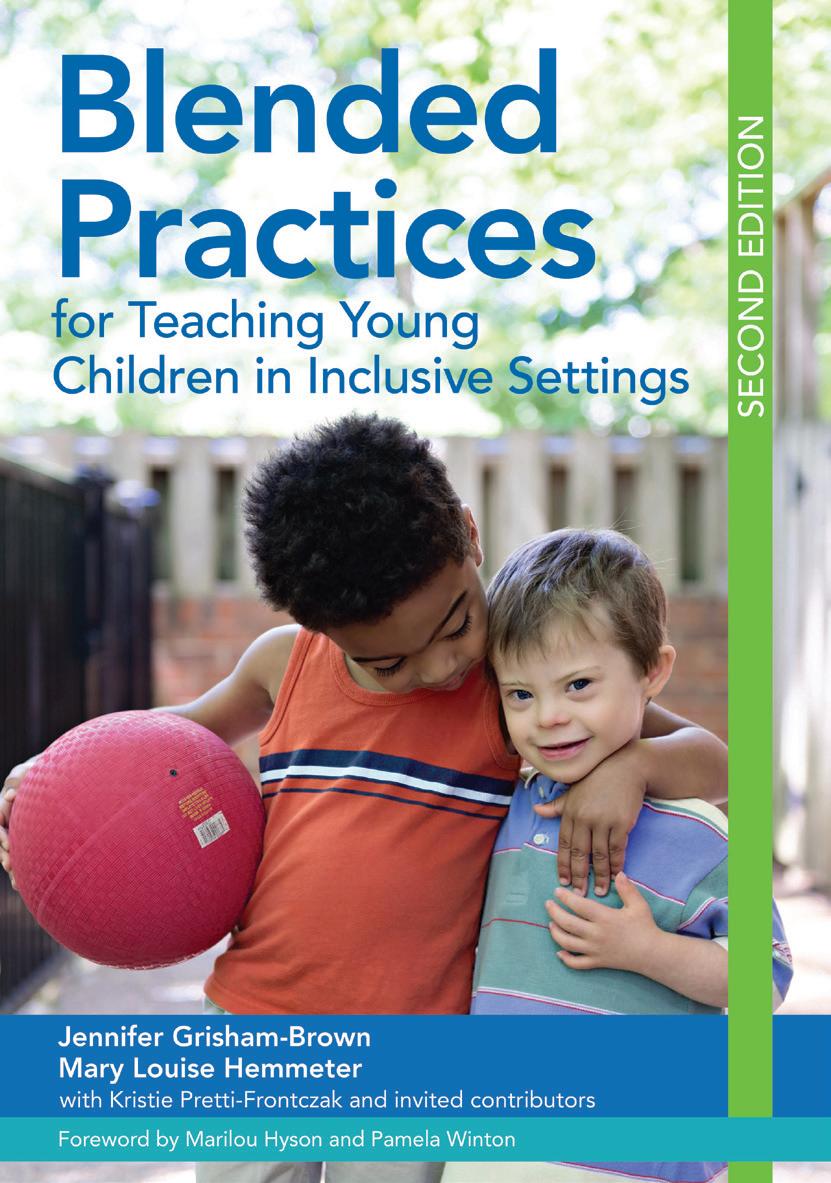
Ideal for current and future early childhood educators working with children from ages 2 to 5, this comprehensive text provides explicit guidance on developing a successful curriculum framework, working effectively with families and other team members, tailoring instruction to each child’s individual needs, and embedding learning opportuni ties that address all children’s goals. Teachers will learn from the field’s most current research, and they’ll get a full continuum of strategies for teaching young children with diverse abilities. Practical information on authentic assessment and data-driven decision-making is also woven throughout the book.
IN THIS EDITION:
• Focus on how to implement multi-tiered systems of support (MTSS)
• New chapters on applying blended practices in specific content areas: language, literacy, social-emotional skills, and math
• The latest on state and federal funding initiatives for early childhood—and how to maintain quality practices that align
More guidance on determining the scope and sequence of what to teach children
Current recommendations from key professional organizations like NAEYC and DEC, and their implications for teachers

Includes visual aids and sample forms, vignettes and practical ex amples that illustrate key concepts and guiding principles, helpful summaries for each chapter, case studies, and learning activities that challenge students to test and expand their knowledge.
I. SETTING THE STAGE FOR BLENDED PRACTICES
Introduction to Blended Practices
Curriculum Framework as a Model of Blended Practices
Identifying Outcomes for Children in Blended Early Childhood Classrooms
Recommended Instructional Practices
TIERED INSTRUCTION
Universal Instructional Practices
Focused Instructional Strategies
Systematic Instructional Practices
SPECIAL CONSIDERATIONS IN THE APPLICATION OF BLENDED PRACTICES
The Team Process of Planning, Implementing, and Revising Instruction
Blended Practices for Promoting Social-Emotional Development in Young Children
Blended Practices for Promoting Literacy Skills
Promoting the Language and Literacy Skills of Dual Language Learners
Blended Practices for Promoting Early Math Skills
”An excellent text for both university students and entry-level and experienced early intervention practi tioners . . . a true example of research to practice.”
—Rachel Moyer-Trimyer, IDEA Part C Specialist, Texas Early Childhood Intervention; lecturer at The University of Texas at Austin
A must for future early interventionists, this introductory text prepares professionals to support infants and toddlers with special needs and their families—and address the OSEP child outcomes so critical to a program’s success. Focusing on the specific needs and challenges of children from birth to three, the book gathers more than a dozen expert contributors with proven expertise in helping children who have or are at risk for developmental delays. Early interventionists will learn recommended practices for family-centered, evidence-based interven tion and team collaboration, knowledge they’ll use for the rest of their careers to ensure the best possible outcomes for infants and young children.
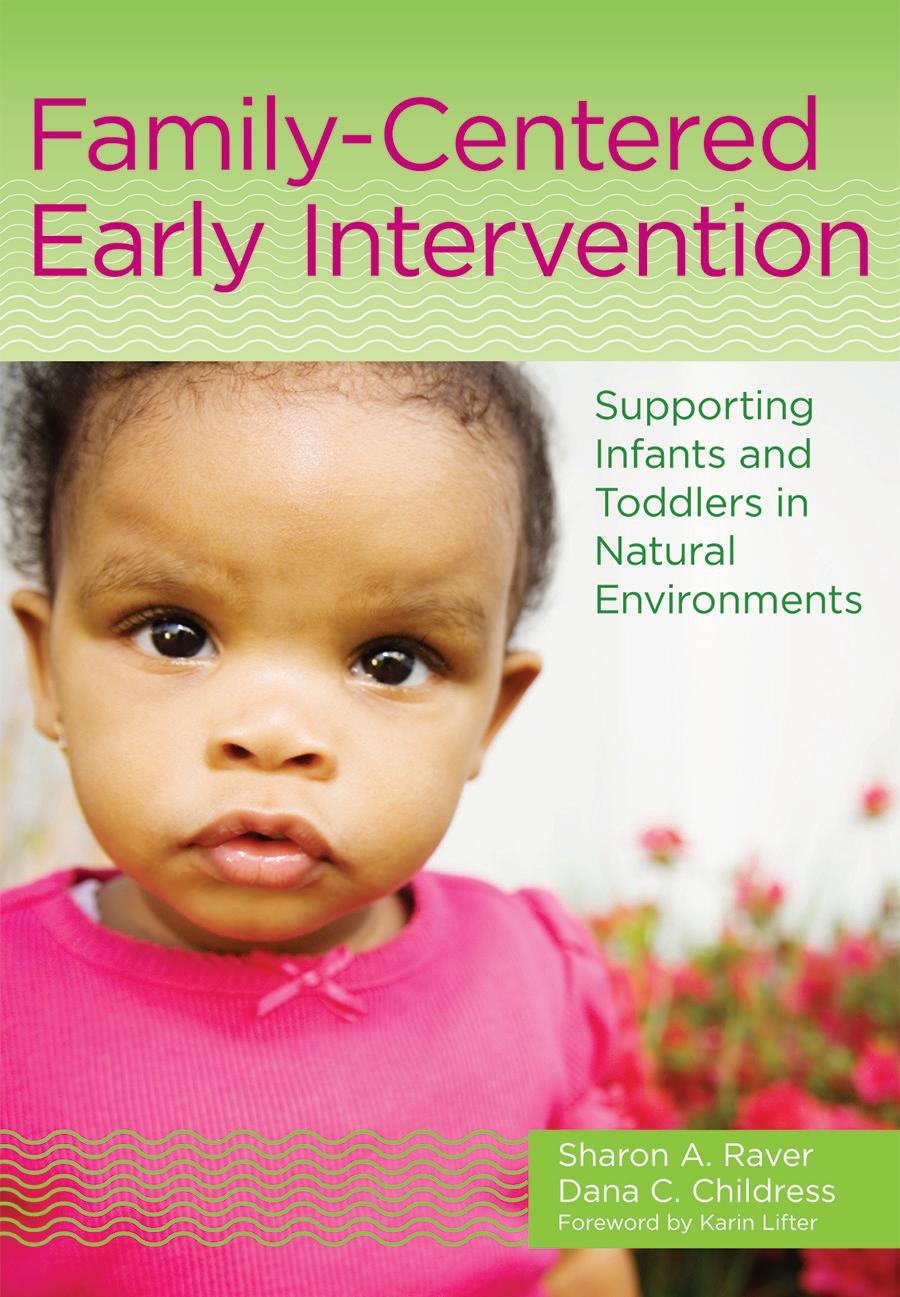
• Addressing the three OSEP Child Outcome Indicators: positive social-emotional skills, acquisition and use of knowledge and skills, and using appropriate behaviors to meet needs
• Developing and implementing IFSPs
• Weaving intervention services into a family’s established routines
• Empowering parents to guide and support their child’s development
• Conducting interventions that support motor, cognitive, socialemotional, communication, and adaptive skills
• Working in effective teams with professionals from diverse disciplines
• Meeting the specific needs of children with all disabilities and/or risk areas, including autism, sensory disabilities, and cognitive and/
Practice Highlights” with specific intervention suggestions, help ful discussion questions, case studies in each chapter that illustrate the

Behavior is one of the biggest and most pressing challenges faced by early childhood educators and providers. Find research-based guid ance and strategies in this essential textbook for professionals prepar ing to work with children from birth to 5.
Your students will start with a comprehensive, reader-friendly overview of early growth and learning across developmental domains, with special emphasis on the components of emotional development and the environmental factors that influence it. Then students will learn the guiding principles for nurturing social-emotional development, aligned with the positive behavioral interventions and supports (PBIS) framework and the Pyramid Model. Concrete examples of specific, research-based strategies prepare future professionals to put the principles into action and improve child outcomes in both center- and home-based settings.
A keystone of professional preparation for preservice early childhood providers, this book will help your students work effectively with chil dren, families, and colleagues to foster social-emotional growth in the critical early years.
• Apply evidence-based universal prevention strategies to proactively support social-emotional growth
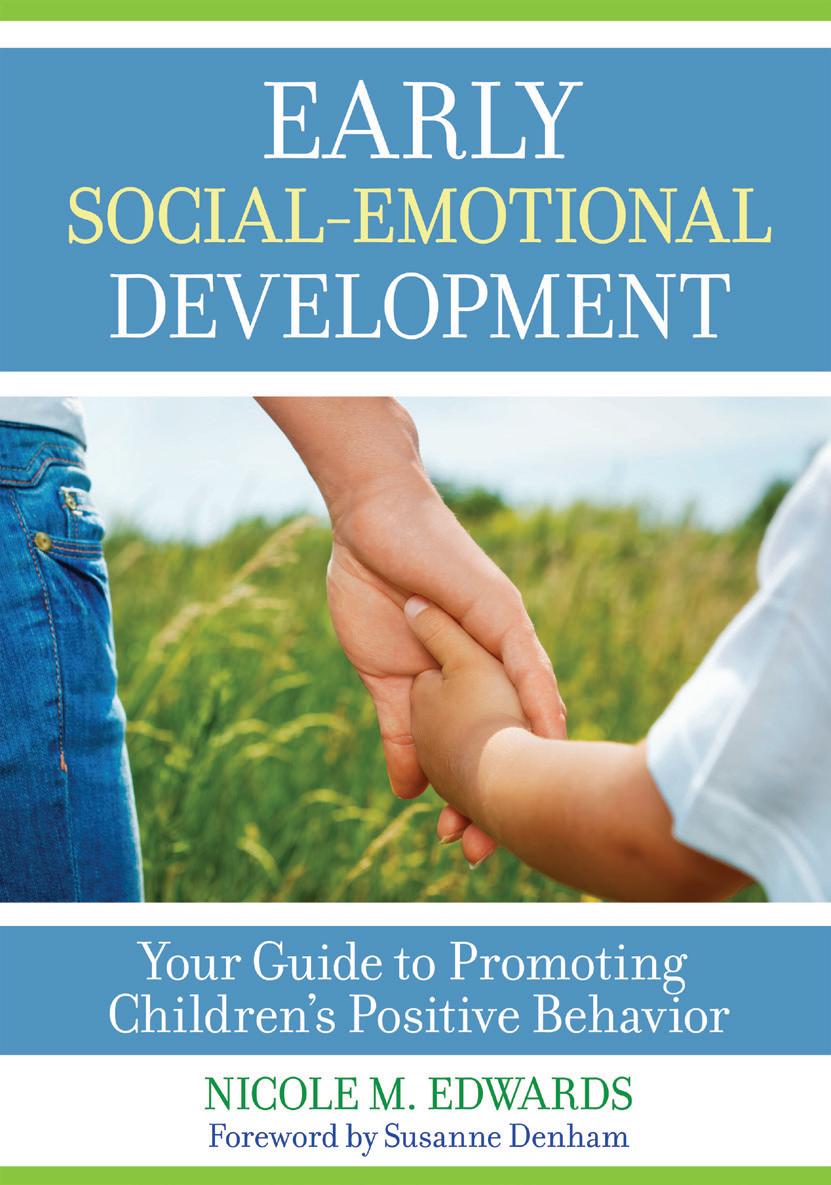
• Collect data and use tailored secondary behavior strategies with children who have more intensive challenges
• Collaborate with families and share concerns sensitively
• Overcome roadblocks to PBIS through team communication and consistency
• Encourage mindfulness in yourself and parental caregivers
• Ensure that providers, caregivers, agencies, and other stakeholders work together and share accountability
• Engage in ongoing reflection to improve your self-efficacy and confidence
Sample scenarios that show how to apply strategies, textboxes on collaborating with families, quotes from parents and educators, reflec tion questions, supplemental exercises, and access to a list of useful web-based resources
I. OVERVIEW: EARLY SOCIAL-EMOTIONAL DEVELOPMENT AND INTERVENTION
The Impact of Early Social-Emotional Development
Environmental Influences and the Educator’s Role
II: SUPPORTING SOCIAL-EMOTIONAL GROWTH

Guiding Principles
Strategies Supporting Social-Emotional Growth
III. WE CAN’T DO IT ALONE: ANTICIPATING AND OVERCOMING OBSTACLES
Potential Roadblocks to Implementing PBIS
Effective Family–Provider Communication
Next Steps for Sustaining Healthy Social-Emotion al Development
After decades of rapid evolution and ground-breaking research, the field of early intervention can be understood within a common frame work: the Developmental Systems Approach (DSA). Created by a highly influential leader in the field, Michael Guralnick, this evidencebased, relationship-oriented, family-centered framework focuses on strengthening the quality of key family patterns of interaction that influence a child’s development.
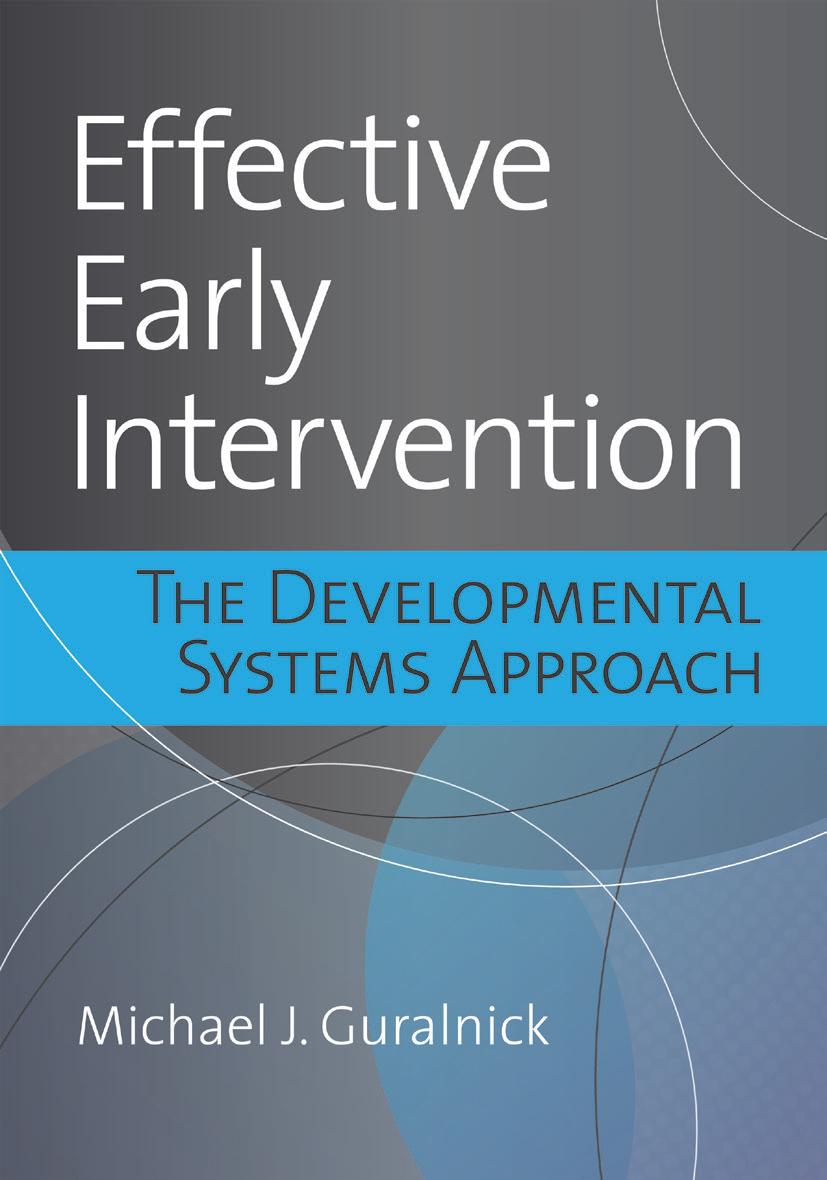
Foundations of Early Intervention
Influences
Development
Early Intervention
Context of
Develop mental Systems Approach
CHILDREN AT BIOLOGICAL RISK: PRETERM BIRTH
Preterm Birth: Developmental Science
Preterm Birth: Intervention Science and Commu nity Systems
CHILDREN AT ENVIRONMENTAL RISK
Environmental Risk: Developmental Science
Environmental Risk: Intervention Science
Community Systems
CHILDREN WITH DEVELOPMENTAL DELAYS
In this important text, Guralnick organizes and analyzes the most cur rent research and developments in early intervention through the lens of the DSA. Starting with a clear explanation of the foundations of early intervention, the book then applies the DSA to four vulnerable populations: children at risk due to biological factors, specifically preterm birth, children at environmental risk, children with devel opmental delays, and children with autism spectrum disorder. Your students will discover how the DSA can guide the development of effective services and supports for diverse young children and fami lies, and they’ll come away with insights on how to use this framework to improve early intervention programs in their own communities. An invaluable textbook for future early childhood researchers, faculty, and policy makers, this forward-thinking book is the key to establishing in clusive community-based early intervention systems that nurture each family’s strengths and promote child development.
Understand the developmental science that applies to all children
Learn how child development is influenced by three critical family patterns of interaction—parent–child transactions, family-orches trated child experiences, and parent promotion of child health and safety
Explore the influence of family resources as well as child-specific risk and protective factors on a child’s health and development in the context of early intervention
CHILDREN WITH AUTISM SPECTRUM DISORDER
Spectrum Disorder:

Spectrum
Discover ways to select interventions that are most effective for children and families based on intervention science and the DSA conceptual framework
the fundamentals of applying the DSA framework to design ing and implementing inclusive community-based systems of early

“An outstanding resource . . . Everything you need for the practical application of ABI is included.”
—Jane Squires, Ph.D., University of Oregon
Teach the nuts and bolts of activity-based intervention (ABI), the trusted, child-directed approach for young children birth to 5. With the fourth edition of this classic textbook—expanded by 30% with practical new content—your students will discover how to embed learning op portunities in everyday activities to help children acquire and generalize functional skills and reach their developmental goals. Future profession als will get a comprehensive introduction to the benefits, challenges, and foundations of ABI, and they’ll find in-depth guidance on how to apply this popular approach with children in center- and home-based programs. Case stories, examples, and sample forms throughout clarify important points and procedures.
• Implement ABI in multiple settings with diverse groups of young children, including kids with disabilities and those at risk
• Create multiple learning opportunities within young children’s natural routines and interactions
• Seamlessly link screening, assessment, goal development, interven tion, and evaluation
• Develop individualized IFSP and IEP goals
Observe children before and after intervention to determine next steps
• Understand and address the challenges of establishing evidencebased practices
• Work as a team with other professionals and families
• New chapters on conducting high-quality child observations, apply ing ABI in centers and in homes, and using ABI with children who have significant disabilities
• Expanded information on key topics, including training paraprofes sionals on ABI and keeping families involved
Updated course companion website with PowerPoint slides, study questions, and application activities

Purpose and Overview
History and Contemporary Status Of Early Intervention/Early Childhood Special Education Programs
Comprehensive Linked System Framework for Service Delivery with Young Children
CONCEPTUAL FRAMEWORK FOR ABI
Description of Activity-Based Intervention
Conceptual Foundations for Activity-Based Intervention
Organizational Structure of Activity-Based Intervention
Blank Forms
Issues Associated with the use of Activity-Based
The Challenges of Intervention Research and the Empirical Bases for an Activity-Based Approach
APPLICATION OF ABI
Observation Skills
Blank Forms
Activity-Based Intervention in Center-Based Programs
Activity-Based Intervention and Home-Based Programs
Using Activity-Based Intervention with Children Who Have Significant Impairments
Activity-Based Intervention and the Team
Considerations for Paraprofessionals in Programs Using Activity-Based Intervention
Early Intervention/Early Childhood Special Educa tion Intervention and Future Accommodations
Expanded with timely new content and consistent with DEC Recommended Practices, the third edition of this bestselling textbook will fully prepare a new generation of early childhood educators to teach and include every child.
Like the groundbreaking previous editions, this updated Building Blocks guide gives preservice teachers three types of practical, evidence-based inclusion strategies: curriculum modifications, embedded learning opportunities, and child-focused instructional strategies. Educators will learn how to apply these three strategies for the benefit of all children; review the latest research that supports the Building Blocks model; and find ready-to-use tips and guidance on key topics, such as fostering friendships, encouraging independence, and promoting positive behavior. Reproducible forms help with planning and assessment, and seven comprehensive new training modules make it easy to teach the Building Blocks framework in college courses and professional development sessions.
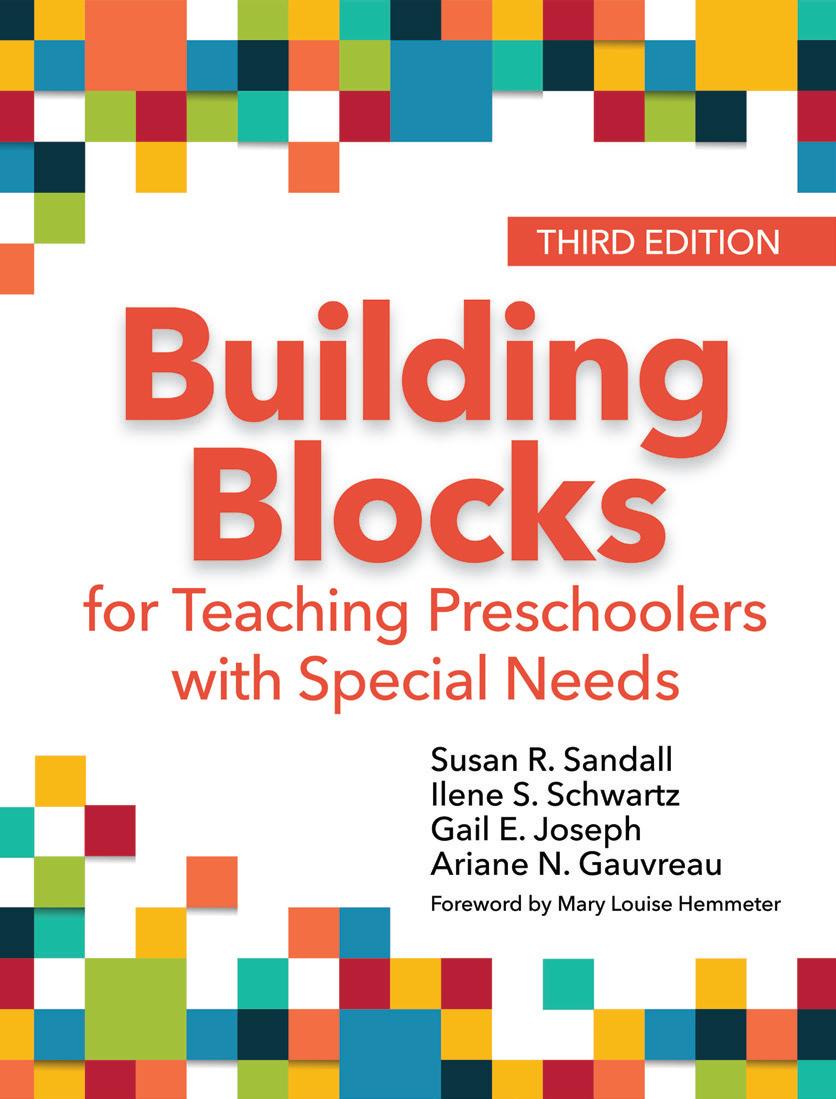

Applying UDL principles to engage every student in a diverse class room
Integrating literacy and STEAM into daily activities and routines
Supporting the executive function skills of all young learners
Applying new and expanded curriculum modifications
Collaborating successfully with other team members to ensure the best child outcomes
classroom quality assessment
By Sallee J. Beneke, Ph.D. (St. Ambrose University), Michaelene M. Ostrosky, Ph.D. (University of Illinois at Urbana-Champaign), & Lilian G. Katz, Ph.D. (Professor Emerita, University of Illinois at Urbana-Champaign)
A proven and popular teaching method, the Project Approach engag es the natural curiosity of children through in-depth investigations of topics that capture their interest. Now there’s a guidebook that shows future educators how use this child-centered approach to reach and teach all learners in their early childhood classroom—regardless of background or ability.
Developed by a team of experts that includes Project Approach leader Lilian G. Katz, this book is a complete guide to implementing project-based learning in inclusive early childhood classrooms. Future teachers will discover how to support diverse groups of children as they study realworld topics that fascinate them, play detective with peers to find answers to questions, and show what they’ve learned in interesting and creative ways. Teachers will also get practical, startto-finish guidance on how to apply the Project Approach, including a complete package of training materials, examples of successful proj ects from real inclusive classrooms, and a Project Approach Implemen tation Checklist that helps educators use the approach effectively.
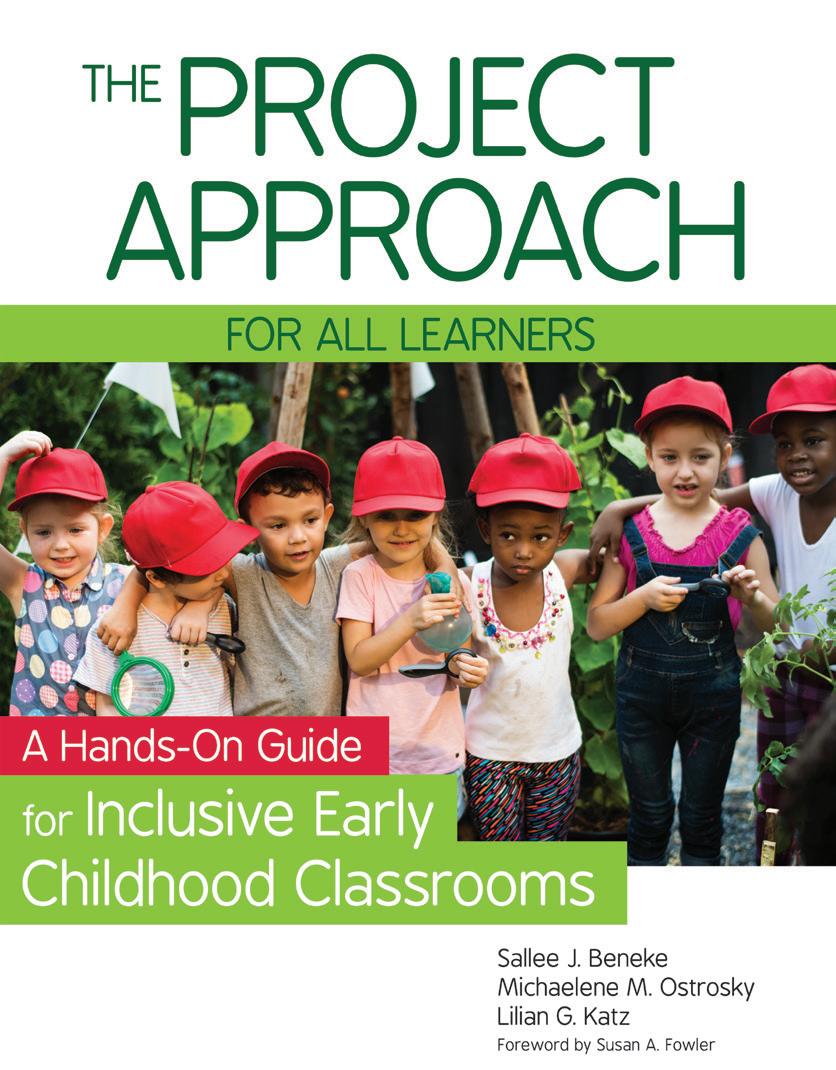
• Use the Project Approach
learning
design
Getting Started with the Project Approach
Defining the Role of the Teacher
Implementing with Fidelity
Supporting the Investigation
Representing and Sharing Project Work
Sustaining the Project Approach
Choose a compelling project topic
hands-on learning
inclusive

Teach children effective strategies
conducting research
Build on children’s natural motivation
listening to them
topic
actively engaging
Make the most of each child’s individual strengths
expertise during project work
Support children in representing their learning through
presentations
accommodations
Your students will master each step of the Project Approach with the comprehensive package of supplementary materials, includ ing the Project Approach Implementation Checklist, 38 video clips that illustrate key concepts, 22 PowerPoint presentations on important elements of the Project Approach, and six sets of training materials that cor respond with each chapter. Supplementary materials are available online to purchasers of the book.

The Brookes Download Hub is your home base for the online course materials— slides, test banks, sample syllabi, and more—that come with Brookes books. Sign up with your faculty email address to download companion materials, “favorite” your books to keep track of your online materials, and get free access to companion materials for ALL Brookes books. Registration is easy—sign up today! https://downloads.brookespublishing.com

You can request exam/desk copies of up to two books that are relevant to your course needs. If you see a book in this catalog that you’re interested in previewing, please look it up on www.brookespublishing.com, click the Request Exam Copy button found on the book’s page, and complete the request form. (All requested information must be supplied before we can process your order.)





